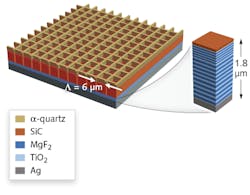PHOTONIC CRYSTALS: Photonic structures enable daytime radiative cooling
With demand for air conditioning skyrocketing worldwide, reducing the need for electricity to cool buildings is an important part of meeting growing global energy demand. With this goal in mind, researchers in professor Shanhui Fan’s group at Stanford University (Stanford, CA) have designed a photonic structure that could enable passive photonic cooling during the hottest hours of the day, with no electricity input needed.1, 2
In a technique called daytime radiative cooling, a photonic structure emits its heat as thermal electromagnetic waves to the cold of outer space, while simultaneously and strongly reflecting sunlight. It exploits an atmospheric transparency window that exists between 8 and 13 μm that allows thermal waves to actually escape to outer space, effectively using it as a heat sink. In doing so, it can rest at an equilibrium temperature substantially below the ambient, providing a passively maintained cold surface.
Photonic-crystal cooling
The photonic design consists of two thermally emitting photonic-crystal layers of silicon carbide (SiC; thickness 8 μm) and quartz (2.5 μm thick) with squares (5.4 μm width) etched in the layers with 6 μm periodicity that sit on top of a broadband solar reflector consisting of three sets of five bilayers of magnesium fluoride (MgF2) and titanium dioxide (TiO2) with varying periods on a silver substrate to form the cooler (see figure).
Essentially, the two-layer, two-dimensional (2D) photonic crystal uses phonon-polariton modes to maximize emissivity in the atmospheric transparency window while the chirped one-dimensional photonic-crystal reflector below minimizes absorbed solar radiation.
The use of dielectric, rather than metallic, substrates allows for minimal solar absorption, while the 2D photonic crystals atop the reflector emit selectively and strongly in the atmospheric window. Together, this design was numerically shown to reach an equilibrium temperature more than 30° below the ambient air temperature, and achieve a cooling power of 100 W/m2 at ambient.
Presenting this work at the Annual Stanford Photonics Research Center (SPRC) Symposium, Stanford University postdoctoral scholar Aaswath Raman said, “Our numerical study indicates that optical design in both the visible and mid-infrared can fundamentally enable a new, and potentially very effective, way of achieving passive cooling during the hottest hours of the day. Beyond homes and buildings, we see opportunities to enable cooling where it is currently not possible, such as for food storage and to keep medicines stocked in rural clinics where electricity is scarce.”
The researchers have received funding from the U.S. Department of Energy’s ARPA-E agency to build and demonstrate the first prototypes of this approach.
REFERENCES
1. A. Raman et al., “Ultrabroadband Nanophotonics to Achieve High-Performance Daytime Radiative Cooling,” poster paper, Stanford Photonics Research Center Symposium, Stanford, CA (2013).
2. E. Rephaeli et al., Nano Lett., 13, 4, 1457 (2013).

Gail Overton | Senior Editor (2004-2020)
Gail has more than 30 years of engineering, marketing, product management, and editorial experience in the photonics and optical communications industry. Before joining the staff at Laser Focus World in 2004, she held many product management and product marketing roles in the fiber-optics industry, most notably at Hughes (El Segundo, CA), GTE Labs (Waltham, MA), Corning (Corning, NY), Photon Kinetics (Beaverton, OR), and Newport Corporation (Irvine, CA). During her marketing career, Gail published articles in WDM Solutions and Sensors magazine and traveled internationally to conduct product and sales training. Gail received her BS degree in physics, with an emphasis in optics, from San Diego State University in San Diego, CA in May 1986.
